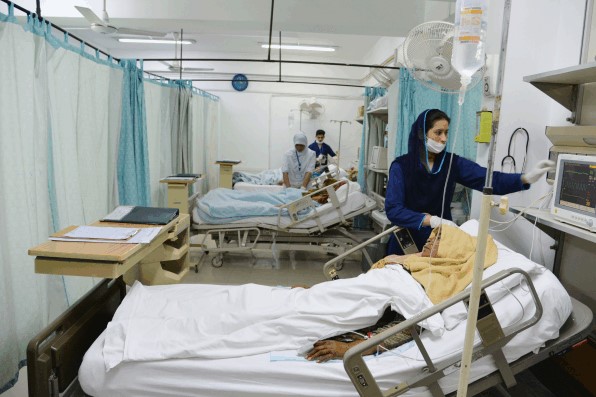
Situation of Intensive Care Units in Pakistan during Covid -19 Pandemic
Intensive Care Units in Pakistan: the COVID-19 pandemic has imposed grave impacts worldwide but the health care systems are being challenged the most around the world.
As the demands of effective health care services are increasing day by day WHO has implemented its guidelines to all countries to reorganize and maintain essential health care services(1).
With the increasing spread of COVID-19, the Intensive care units are facing a terrible burden in health care settings all across the globe.
Intensive Care Unit in Pakistan, how is the COVID-19 pandemic being managed?
To manage the ICU surge during COVID-19 several recommendations are being proposed such as using alternative methods of ventilation during a shortage of standard ventilators, increasing the number of ventilators, beds, medical staff such as doctors, nurses, and paramedics, formulation of inventory of essential supplies and equipment in intensive care units (2).
To analyze the situation of intensive care in Pakistan a cross-sectional survey was conducted in all the intensive care units (ICUs) of hospitals that are recognized for postgraduate training.
According to which a total number of 151 hospitals are providing 2166 ICU beds and 1473 ventilators. However, there is a marked disparity in the distribution of intensive care equipment and ventilators among provinces.
The intensive care training of doctors and nurses is also needed(3).
Pakistan, the marked difference between intensive care units in large centres and in the provinces
Moreover, according to the DAWN report of June 2020, the situation of intensive care in Pakistan is worsening as the hospitals all across the country are running short of capacity especially in terms of availability of a total number of ventilators in hospitals of all provinces(4).
As the second wave of COVID-19 is gripping, the situation of intensive care in Pakistan is getting even worse because the ICUs are nearing capacity.
According to the secretary-general of the Pakistan Medical Association around 95 percent of beds in all hospitals are occupied and most of the hospitals are refusing to admit more patients(5).
As oxygen therapy is crucial for patients with severe COVID-19 that are admitted in intensive care units, the oxygen provision should be a priority in resource-poor settings like Pakistan.
Therefore, assuring the availability of supplemental oxygen therapy should be a primary focus(6).
Early detection of Covid-19 cases can ease the workload for intensive care units
The National Command and Operation Centre NCOC set up by the government of Pakistan is continuously monitoring the situation of COVID-19 in the country.
The government of Pakistan has established many facilities such as designated tertiary care hospitals, isolation wards, quarantine facilities, and testing facilities to combat the pandemic.
For instance, the Government has provided 215 medical facilities with 2942 beds all over the country(7)
To prevent transmission and to mitigate the burden on intensive care units in Pakistan our healthcare system must ensure an efficient surveillance system that can identify, isolate, quarantine, and treat suspected and confirmed individuals.
The government must ensure the hospital’s preparedness with the presence of triage stations and ensure the availability of personal protective equipment PPE such as surgical masks, face shields, gloves, and gowns.
The public also needs to follow SOPS to prevent viral transmission this way the burden on health care settings, especially on intensive care units can be reduced (8).
Article written for Emergency Live by Dr Rabia Anees
READ ALSO:
Emergency Medical Technician (EMT) Roles And Functions In Pakistan
Ambulance In Asia: What Are The Most Commonly Used Stretchers In Pakistan?
Post-Intensive Care Syndrome (PICS) And PTSD In COVID-19 Patients: A New Battle Has Begun
COVID-19 Variant, How Do Intensive Care Units Work In The UK?
REFERENCES AND SOURCE:
1. Mantenimento dei servizi sanitari essenziali [Internet]. [citato 2021 gen 8]. Disponibile da: https://www.who.int/emergencies/diseases/novel-coronavirus-2019/related-health-issues
2. Aziz S, Arabi YM, Alhazzani W, Evans L, Citerio G, Fischkoff K, et al. Gestione del surge ICU durante la crisi COVID-19: linee guida rapide. Intensive Care Med. 2020 Jul 1;46(7):1303-25.
3. Hashmi M, Taqi A, Memon MI, Ali SM, Khaskheli S, Sheharyar M, et al. Un sondaggio nazionale dei servizi di assistenza critica negli ospedali accreditati per la formazione in un paese a basso reddito medio: Pakistan. J Crit Care. 2020 Dec 1;60:273-8.
4. Ospedali sotto tensione come Covid-19 picco si avvicina – Pakistan – DAWN.COM [Internet]. [citato 2021 Jan 8]. Disponibile da: https://www.dawn.com/news/1562323
5. Ospedali pieni mentre la seconda ondata di virus attanaglia il Pakistan – France 24 [Internet]. [citato 2021 gen 7]. Disponibile da: https://www.france24.com/en/live-news/20201125-hospitals-full-as-second-wave-of-virus-grips-pakistan
6. Dondorp AM, Hayat M, Aryal D, Beane A, Schultz MJ. Supporto respiratorio in pazienti COVID-19, con un focus sulle impostazioni limitate alle risorse [Internet]. Vol. 102, American Journal of Tropical Medicine and Hygiene. American Society of Tropical Medicine and Hygiene; 2020 [citato 2021 Jan 8]. p. 1191-7. Disponibile da: https://pubmed.ncbi.nlm.nih.gov/32319424/
7. COVID-19 Health Advisory Platform by Ministry of National Health Services Regulations and Coordination [Internet]. [citato 2021 gen 8]. Disponibile da: https://covid.gov.pk/stats/pakistan
8. Mukhtar S. Predisposizione e misure proattive di controllo delle infezioni del Pakistan durante l’epidemia di COVID-19 [Internet]. Vol. 17, Ricerca in farmacia sociale e amministrativa. Elsevier Inc.; 2020 [citato 2021 Jan 8]. p. 2052. Disponibile da: https://www.ncbi.nlm.nih.gov/pmc/articles/PMC7151296/


